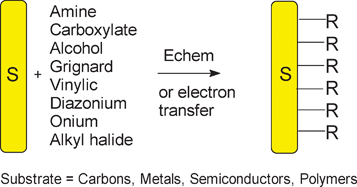Electrografting refers to the electrochemical reaction that permits organic layers to be attached to solid conducting substrates. This definition can be extended to reactions involving an electron transfer between the substrate to be modified and the reagent, but also to examples where a reducing or oxidizing reagent is added to produce the reactive species. These methods are interesting as they provide a real bond between the surface and the organic layer. Electrografting applies to a variety of substrates including carbon, metals and their oxides, but also dielectrics such as polymers. Since the 1980s several methods have been developed, either by reduction or oxidation, and some of them have reached an industrial stage. This critical review describes the methods that are used for electrografting, their mechanism, the formation and growth of the layers as well as their applications (742 references).
You have access to this article
 Please wait while we load your content...
Something went wrong. Try again?
Please wait while we load your content...
Something went wrong. Try again?


 Please wait while we load your content...
Please wait while we load your content...